Thursday, 24th November 2022
India is losing its cherished right to know: The Hindu
Right to Information (RTI) Act
Exam View: Right to Information (RTI) Act, Central Information Commission, State Information Commission, Transparency & Accountability
In News: India is losing its cherished right to know.
Central Information Commission, the apex body under India’s transparency regime, is to decide whether certain information sought by a citizen ought to be disclosed or not. Its primary duty is to decide the disclosure or the non-disclosure of information.
The Right to Information Act 2005 mandates timely response to citizen requests for government information.
The basic object of the Right to Information Act is to empower the citizens, promote transparency and accountability in the working of the Government, contain corruption, and make our democracy work for the people in a real sense.
Citizens can file applications under the Right to Information Act with any public body and are guaranteed a reply from the public information officer of that public body within 30 days.
In case of a no reply or dissatisfaction with the response, the citizen can file an appeal at the departmental level and then a second and final appeal with the Information Commission. Each State has its own State Information Commission to deal with second appeals concerning State bodies.
Right to Information (Amendment) Act, 2019:
- It provided that the Chief Information Commissioner (CIC) and an Information Commissioner (IC) shall hold office for such term as prescribed by the Central Government or until they attain the age of 65 years, whichever is earlier.
- It provided that the salary, allowances and other service conditions of the CIC and IC shall be such as prescribed by the Central Government.
- Before this amendment, the salary, allowances, and other service conditions of the CIC were similar to those of the Chief Election Commissioner and that of an IC were similar to those of an Election Commissioner. They had a five-year fixed term and terms of service.
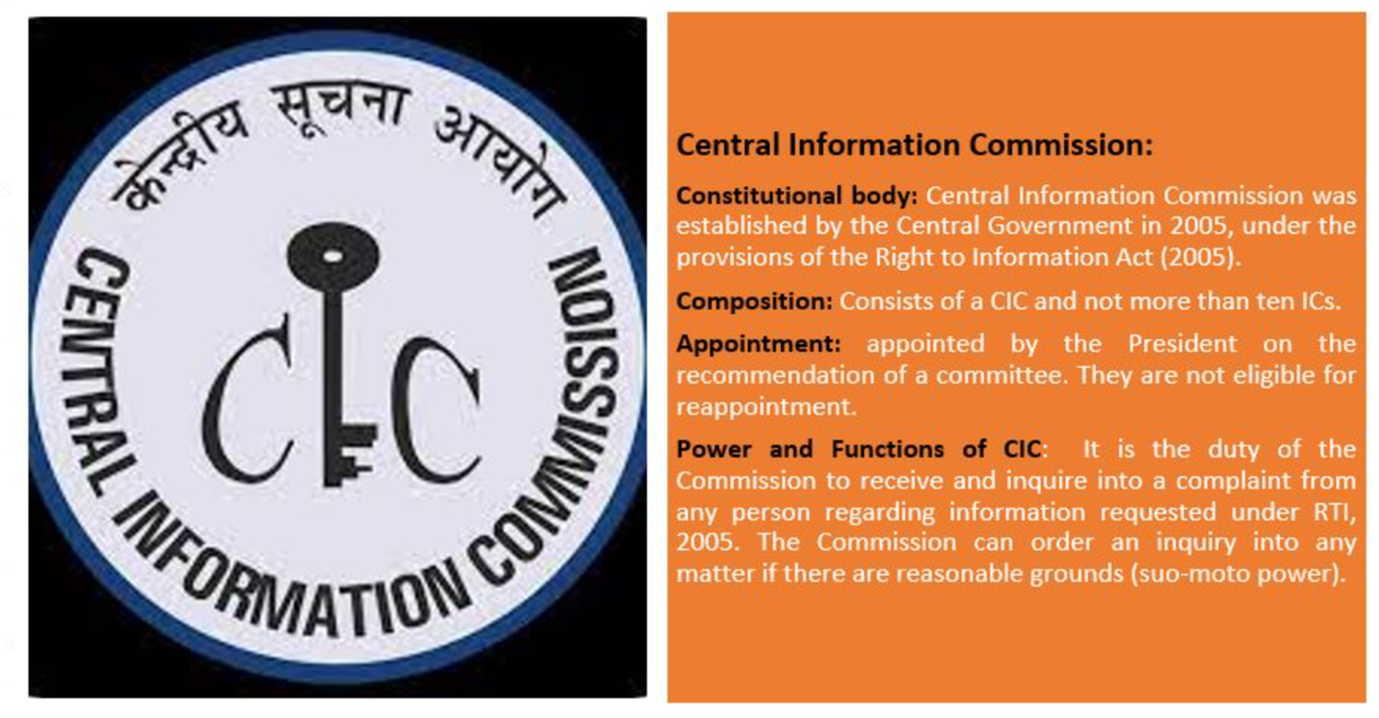
Issues in the RTI Implementation:
 Way Forward:
Way Forward:
Functioning of Information Commissions: Proper functioning of information commissions is crucial for people to realise their right to information. Under the RTI law, information commissions are the final appellate authority and are mandated to safeguard and facilitate people’s fundamental right to information.
Transparency Watchdog: There is an urgent need for the transparency watchdogs to function in a more effective and transparent manner.
Digital RTI Portal: The digital RTI portal (website or mobile app) can deliver more efficient and citizen-friendly services which are not possible through conventional mode. This will be beneficial for both transparency seekers and the government.
https://www.thehindu.com/opinion/op-ed/india-is-losing-its-cherished-right-to-know/article66175139.ece
Click the link below to attempt the daily MCQs and the Mains based questions.
Fixing India’s malnutrition problem: The Hindu
In News:
The poor rank of India in the Global Hunger Index 2022, points towards systemic challenges in the strategy to eradicate malnutrition in India. India ranked 107 out of 121 countries behind Pakistan, Bangladesh and Nepal.

- Concern Worldwide and Welthungerhilfe have released the latest edition of the Global Hunger Index report. It ranked India 107th out of 121 countries.
- Even India’s National Family Health Survey (NFHS-5) from 2019-21 reported that in children below the age of five years, 5% were stunted, 19.3% showed wasting, and 32.1% were underweight.
- Although NFHS-5 has shown marginal improvement in different nutrition indicators, it points out that the pace of progress is slow.
|
Various government interventions to tackle malnutrition
|
Why India continues to perform dismally in tackling malnutrition despite several intervention?

- Underfunding of schemes is a major reason for the failure of such schemes. For example, there has been a marginal increase in budgetary allocation for ICDS between 2020 to 2022.
- Underutilization of funds due to paucity of manpower results in the poor on-ground implementation of schemes. For example, 50% of Child Development Project Officer (CDPO) posts were vacant in Jharkhand, Assam, Uttar Pradesh, and Rajasthan,
- Cash transfers which seem to be favoured solution for several social sector interventions are also limited due to volatile food process and inflation impacts.
- Social factors such as son preference, influence household-level decisions when responding to the nutrition needs of sons and daughters.
What should be the way forward in solving the crisis of malnutrition in India?
- Targeted Public Distribution System where food rations through PDS and special supplements for the target group of pregnant and lactating mothers, infants and young children are provided.
- Adequate budgetary support is extremely crucial in ensuring the efficiency and effectiveness of government interventions.
- Greater involvement of local government and local community groups in the design and delivery of tailored nutrition interventions.
- Augmenting public service delivery capabilities by regular recruitments at posts like CDPO and AWW. Furthermore Enhancing the knowledge and skills of AWWs and the supervisory capabilities of CDPOs is also necessary.
Source:
- https://www.thehindu.com/opinion/lead/fixing-indias-malnutrition-problem/article66175213.ece
- https://www.thehinducentre.com/the-arena/article26397464.ece
Image Source:
- https://swachhindia.ndtv.com/national-nutrition-week-2019-the-crisis-of-malnutrition-in-india-37531/
Click the link below to attempt the daily MCQs and the Mains based questions.
Changing El Niño-La Niña weather patterns
In News:
- According to the study published recently in the Nature Communications journal, climate change is expected to significantly impact El Niño-La Niña weather patterns by 2030 — a decade before what was earlier predicted.
Beyond News:
- El Niño and La Niña are the warm and cool phases of a recurring climate pattern across the tropical Pacific—the El Niño-Southern Oscillation, or “ENSO” for short.
- The pattern shifts back and forth irregularly every two to seven years, bringing predictable shifts in ocean surface temperature and disrupting the wind and rainfall patterns across the tropics.
- These changes have a cascade of global side effects and any change in pattern is bound to result in further global climate disruptions.
Major findings of the study:

- About: The combination of El Niño, La Niña, and the neutral state between the two opposite effects i.e., El Niño Southern Oscillation (ENSO) is significant enough to influence global climate.
- Sea temperature variability: Increased Sea Surface Temperature (SST) variability from ENSO in the eastern Equatorial Pacific (EP) will emerge around 2030, more than a decade earlier than that of the central Pacific (CP) ENSO.
- Preliminary trends: If Central Pacific and Equatorial Pacific are not separated, SST variability from ENSO will occur almost four decades earlier than previously suggested.
- Shift in pattern: Changes in the equatorial Pacific will be visible first due to a stronger increase in the EP-ENSO rainfall response, leading to increased SST variability.
Impact on India’s monsoons:
- Effect of El Niño: It causes weak rainfall and more heat and at present, India, like the rest of the globe, is witnessing an extended ‘triple dip’ La Niña leading to surplus rain in September, a month that usually sees the monsoon retreat, for the third year in a row.
- Effect of La Nina: It intensifies rainfall across South Asia, particularly in India’s northwest and Bangladesh during the monsoon.
|
El Niño |
La Niña |
|
|
Source: https://phys.org/news/2022-11-climate-eastern-pacific-weather-patterns.html
Click the link below to attempt the daily MCQs and the Mains based questions.
Slowing dragon, racing elephant: China and India population
In News:
China will for the first time register an absolute decline in its population in 2022. Whereas India’s population, as projected by the UN, is expected to surpass that of China in 2023.
What are the factors responsible for such a shift in demography?
- Reduced Mortality Rate: Due to increased education levels, public health and vaccination programmes, access to food and medical care, and provision of safe drinking water and sanitation facilities, the crude death rate has fallen from double-digit to single-digit for both countries. In 2020 it was 7.3-7.4 for both nations.
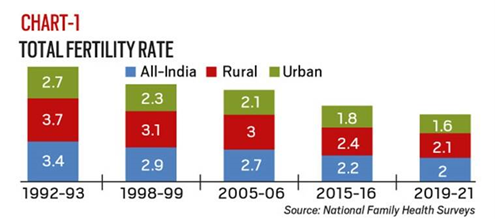
- Increasing life expectancy at birth: Between 1950 and 2020, it went up from 43.7 to 78.1 years for China and from 41.7 to 70.1 years for India.
- Drop in Fertility Rates:
- The total fertility rate (TFR) is the number of babies an average woman bears over her lifetime.
|
A TFR of 2.1 is considered Replacement-level fertility. This means a woman having two children basically replaces herself and her partner with two new lives. Since all infants may not survive to realize their reproductive potential, the replacement TFR is taken at slightly above two. It ensures that each generation replaces itself. |
-
- Reduction in TFR from 3.4 to 2 between 1992-93 and 2019-21 has resulted in a slowing down of population growth in India.
Why is the population of India still rising despite TFR being below replacement levels?
- De-growth in the population requires TFRs to remain below replacement levels for an extended period. The effects of low TFR i.e. fewer children today becoming parents tomorrow and procreating just as much or less, may reflect only after a couple of generations.
- China’s TFR dipped below replacement first in 1991, which was almost 30 years before India’s, ultimately resulting in absolute declines in population in 2022 for China.
How is the demographic shift a concern for China and an opportunity for India?
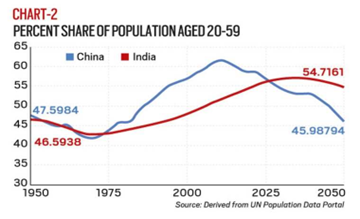
- Concern for China:
- The decline in the prime working-age population creates a vicious cycle wherein the number of working people to support their dependents decreases but the number of dependents starts increasing. In response, China officially ended its one-child policy, introduced in 1980, in 2016.
- As the working-age population peaked at 61.5% in 2011, it also coincided with its economic growth. Thus declining demography thus could also affect the economic growth of China.
- Opportunity for India:
- India has an opportunity of reaping a demographic dividend the working-age population’s share in the overall population crossed 50% only in 2007 and will peak at 57% towards the mid-2030s.
- However, reaping demographic dividend is contingent upon the creation of meaningful employment opportunities for a young population outside agriculture in the field of manufacturing and modern services.
Source:
- https://indianexpress.com/article/explained/explained-global/china-india-population-growth-mortality-fertility-explained-8281340/
Click the link below to attempt the daily MCQs and the Mains based questions.
Development of Great Nicobar: Imperative and Concerns
In news
The Ministry of Environment, Forest and Climate Change has given environmental clearance for a 'Rs 72,000 crore development project' on the strategically important Great Nicobar Island, which is to be implemented in three phases over the next 30 years.
About Great Nicobar Island

- Great Nicobar forms the southernmost of the Andaman and Nicobar Islands, in the eastern Bay of Bengal.
- Indira Point on the southern tip of Great Nicobar Island is India’s southernmost point.
- It is home to two national parks (Galathea Bay and Campbell Bay National Park), a biosphere reserve, and the Shompen and Nicobarese tribal people.
- The Island has tropical wet evergreen forests, and the leatherback sea turtle is the island’s flagship species.
About the Development Plan
- The Indian government’s ambitious plans include:
- Development of an international container trans-shipment terminal
- Military-civil dual-use airport
- Solar power plants and
- An integrated township
- For the project, the MoEF has sanctioned the diversion of just over 130 square kilometres of forest land and the felling of around 8.5 lakh trees, all of which is likely to affect the mangrove cover and coral reef in the area.
Imperative for Development
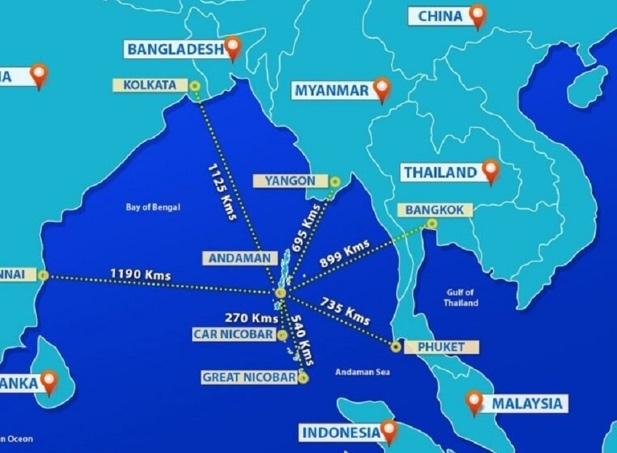
- China expanding its footprint in the Indian Ocean region makes it imperative for India to consolidate strategically on the islands, from the perspective of National Security as well.
- The proposed port will allow Great Nicobar to participate in the regional and global maritime economy by becoming a major player in cargo transhipment.
- More than 1 lakh new direct jobs and 1.5 lakh indirect jobs are likely to be created on the island.
- Leverage Tourism potential, to drive the local economy.
Ecological concerns
- The loss of tree cover will affect the flora and fauna on the island, which further will lead to increased runoff and sediment deposits in the ocean, impacting the coral reefs in the area, and thereby disturbing the region's ecological balance.
- Environmentalists have also flagged the loss of mangroves on the island, due to the development plan.
- New hotels, resorts, and a transhipment port could upend decades of conservation efforts.
Mitigation efforts
The Mitigation efforts being undertaken to minimise the ecological impact include:
- MoEF has involved the Zoological Survey of India (ZSI), Wildlife Institute of India (WII) and Salim Ali Centre for Ornithology and Natural History (SACON) in examining the matter, related to the project.
- The ZSI has been entrusted with the responsibility of translocating part of the coral reef that will be affected by the project.
- The WII, is putting in place a conservation management plan for the leatherback turtle as well.
Source:
- Development of Great Nicobar: strategic imperative and ecological concerns
Image source:
- https://images.indianexpress.com/2022/11/nicobar.jpg
- https://dras.in/wp-content/uploads/2021/12/anc.jpg
Click the link below to attempt the daily MCQs and the Mains based questions.
Champions of the Earth Award - Edukemy Current Affairs
- Context: Purnima Devi Barman has been honoured UN’s highest environmental award, for her campaign to protect the 'hargila', or stork, in 2007, focusing on the villages in Assam’s Kamrup District where the birds were most concentrated.
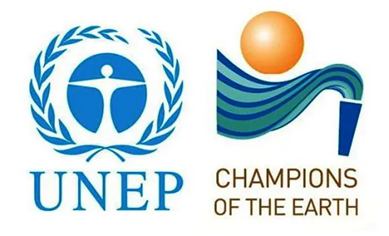
- The Champions of the Earth, since its inception in 2005, is to recognise innovative ways implemented by the awardees to support nature’s extraordinary capacity for renewal.
- The awards celebrate inspirational and motivational examples of individual and collective action to change the world.
- Champions of the Earth award in the Entrepreneurial Vision category is the UN’s highest environmental honour.
- Pursuing UN Decade on Ecosystem Restoration (2021-2030), this year’s award is focused on efforts to prevent, halt and reverse ecosystem degradation globally.
- Ecosystem restoration is essential to:
- keeping global warming below 2°C and helping societies and economies to adapt to climate change.
- crucial to fighting hunger: restoration through agroforestry alone has the potential to increase food security for 1.3 billion people.
- restoring 15 per cent of converted lands could reduce the risk of species extinction by 60 per cent.
Sources:
- https://indianexpress.com/article/explained/purnima-devi-barman-honoured-uns-highest-environmental-award-unep-8284323/
- https://www.unep.org/news-and-stories/press-release/uns-highest-environmental-honour-celebrates-ecosystem-restoration
Click the link below to attempt the daily MCQs and the Mains based questions.
Guru Tegh Bahadur - Edukemy Current Affairs
- Context: November 24, is commemorated as the Shaheedi Divas of Guru Tegh Bahadur.
- Guru Tegh Bahadur was born in Amritsar on April 21, 1621, to Mata Nanki and Guru Hargobind, the sixth Sikh guru.

- He was the ninth guru of the Sikhs, who stood up against forcible conversions by the Mughals, and was executed on the orders of Aurangzeb in 1675.
- To honour and respect his martyrdom, November 24th is known as the Shaheedi Divas.
- His execution and cremation sites in Delhi, Gurudwara Sis Ganj Sahib and Gurudwara Rakab Ganj Sahib, became Sikh sacred places.
- The Guru's great sacrifice was to vindicate the people's right to profess and practice their faith.
- In his hymns, he stresses on
- The unreality of human passions and possessions,
- our awareness of the transience of material phenomena. He elevates the human mind and imbues it with hope.
- keeping our attention focused on the everlasting and eternal.
- Guru Tegh Bahadur composed 116 shabads and 15 ragas, and his teachings have been included in the Adi Granth.
Sources:
- https://indianexpress.com/article/explained/guru-tegh-bahadur-shaheedi-divas-8285807/
- https://www.researchgate.net/publication/351308696_Holistic_Vision_of_Sri_Guru_Tegh_Bahadur_Ji_Part_-1
Image source:
- https://theprint.in/features/guru-tegh-bahadur-martyrdom-day-know-all-about-the-great-sikh-guru/1232834/
Click the link below to attempt the daily MCQs and the Mains based questions.
Outbreak in India: Urgent Measures Needed
- Context: There has been a measles outbreak in several different states of India.
- Measles is caused by a contagious airborne virus in the paramyxovirus family. The virus infects the respiratory tract and then spreads throughout the body.
- Measles is a human disease and is not known to occur in animals.
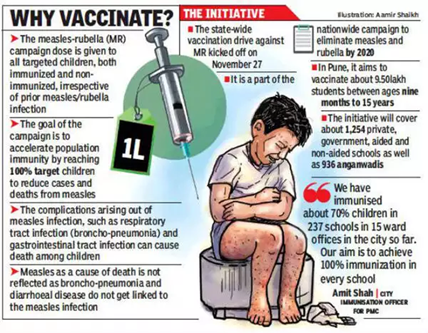
- Symptoms and Spread: It is spread by coughing and sneezing, close personal contact or direct contact with infected nasal or throat secretions.
- Asian countries that eliminated measles: Bhutan (2017), Maldives (2017), North Korea (2018), Sri Lanka (2019), and Timor-Leste (2018).
- GOI’s Initiative
- Measles vaccination falls under the Universal Immunisation Programme. India has a target of eliminating the viral disease by 2023.
- Measle Rubella Campaign 2017-18
- Global Initiative:
- Measles & Rubella Initiative (M&R Initiative) is a global partnership led by the American Red Cross, United Nations Foundation, Centers for Disease Control and Prevention (CDC), UNICEF and WHO which was initiated in
- The Initiative helps countries plan, fund and measure efforts to stop measles and rubella for good.
- Measles & Rubella Initiative (M&R Initiative) is a global partnership led by the American Red Cross, United Nations Foundation, Centers for Disease Control and Prevention (CDC), UNICEF and WHO which was initiated in
Source:
- https://www.who.int/news-room/fact-sheets/detail/measles
- https://www.thehindu.com/news/national/other-states/centre-rushes-teams-to-help-contain-measles-outbreak/article66175007.ece
Image source:
- https://www.cdc.gov/measles/symptoms/signs-symptoms.html
Click the link below to attempt the daily MCQs and the Mains based questions.
Credit Deposit ratio - Edukemy Current Affairs
Why in news? The credit Deposit ratio of Northern and Western Regions declined in 2022 and that of North-Eastern, Eastern, Central and Southern Regions improved.
About:
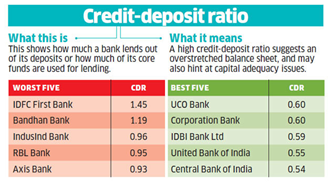
- The credit Deposit ratio tells how much money banks have raised in form of deposits has been deployed as loans.
- Low Credit Deposit ratio:
- It suggests relatively poor credit growth compared with deposit growth.
- It also indicates banks are not making full use of their resources.
- High Credit Deposit ratio:
- It means strong demand for credit with relatively slower deposit growth.
- It also indicates pressure on resources.
https://www.thehindubusinessline.com/money-and-banking/credit-deposit-ratio-of-northern-and-western-regions-declined-in-2022-rbi-data/article66165033.ece/amp/
Click the link below to attempt the daily MCQs and the Mains based questions.
Black napped Pheasant - Edukemy Current Affairs
Why in news? Recently, Scientists captured the first-ever video of an extremely rare and endangered bird that had been lost to science for 140 years.
About:

- It is a large, ground-dwelling pigeon with a broad tail.
- The bird is found in the primary rainforests of New Guinea and nearby islands.
- It ranges primarily over hilly and lower mountain areas but can also be found in lowlands.
- It has four subspecies - White-naped pheasant pigeon, Green-naped pheasant pigeon, Grey-naped pheasant pigeon, Black-naped pheasant pigeon.
- IUCN status: Critically Endangered.
https://www.timesnownews.com/viral/bird-lost-to-science-gets-captured-on-camera-for-the-first-time-in-140-years-can-you-guess-the-species-watch-article-95672215/amp
Click the link below to attempt the daily MCQs and the Mains based questions.
PM-KISAN - Edukemy Current Affairs
Why in news? Recently, the number of beneficiaries under the PM-KISAN scheme has crossed 10 crores.
About:

- PM-KISAN is a central sector scheme, launched in 2019, to supplement the financial needs of land-holding farmers.
- It is being implemented by the Ministry of Agriculture and Farmers Welfare.
- It provides an income support of Rs 6,000 per year in three equal instalments to all land holding farmer families.
- The fund is being directly transferred to the bank accounts of the beneficiaries.
- So far, the Centre has released 12 instalments of funds under the scheme.
https://m.economictimes.com/news/economy/agriculture/govt-says-number-of-beneficiaries-under-pm-kisan-has-crossed-10-crore/amp_articleshow/95667864.cms
Click the link below to attempt the daily MCQs and the Mains based questions.
Climate Change Performance Index
Why in news? Recently, India ranked 8th as per Climate Change Performance Index (CCPI, 2023) published by German Watch at COP 27.
About:
- Published annually since 2005, It is an independent monitoring tool for tracking the climate protection performance of 59 countries and the European Union.
- These countries together generate 92% of global greenhouse gas emissions (GHG).
- CCPI is assessed in four categories: GHG Emissions (40% of the overall score), Renewable Energy (20% of the overall score), Energy Use (20% of the overall score) and Climate Policy (20% of the overall score).
https://www.pib.gov.in/PressReleasePage.aspx?PRID=1878023#:~:text=India%20improves%202%20ranks%20in,climate%20change%20policies%20and%20actions.&text=India%20has%20been%20ranked%20amongst,on%20its%20Climate%20Change%20performance
Click the link below to attempt the daily MCQs and the Mains based questions.
National Centre of Excellence for Green Port & Shipping (NCoEGPS)
- Why in news? Recently, India’s first NCoEGPS was launched at “INMARCO 2022” held in Mumbai.
- About:
- It is a major initiative by the Ministry of Ports, Shipping and Waterways (MoPSW) towards providing greener solutions.
- The NCoEGPS will be working under the framework of the Sagarmala programme of the MoPSW.
- The Energy and Resources Institute (TERI) is the knowledge and implementation partner for this project.
- The centre aims to develop a regulatory framework and alternate technology adoption road map for Green Shipping to foster carbon neutrality and circular economy (CE) in shipping sector in India.
https://pib.gov.in/PressReleaseIframePage.aspx?PRID=1877297
Click the link below to attempt the daily MCQs and the Mains based questions.
Ethnoveterinary medicine (EVM)
Why in news? Recently, a Delhi-based think-tank, released a special report titled Ethnoveterinary medicine (EVM): An alternative to antibiotics for the dairy sector to mark World Antimicrobial Awareness Week (WAAW).
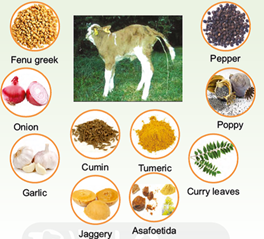 About:
About:
- Ethnoveterinary medicine (EVM) involves the use of traditional/herbal preparations in treating diseases of cattle.
- An Ethnoveterinary study on medicinal plants used by the Buyi people in Southwest Guizhou, China.
- Advantages of Ethnoveterinary medicine-
- Reduces Antibiotics use
- Preserve herbs.
- User-friendly, Eco friendly.
- Cost-effective
https://www.downtoearth.org.in/news/health/amp/antimicrobial-resistance-new-cse-report-focuses-on-major-ethnoveterinary-medicine-programme-86091
Click the link below to attempt the daily MCQs and the Mains based questions.
Revolt against the British: Tipu Sultan
MYSORE TIGER: TIPU SULTAN
Background
Tipu Sultan was a ruler of the Kingdom of Mysore and the eldest son of Sultan Hyder Ali. He was an educated ruler, having studied the Quran, Islamic jurisprudence, languages, philosophy and science. He was also adept in the art of warfare.
What has been the reason for the political controversy surrounding Tipu Sultan?
The historical legacy of Tipu Sultan has often been contested by a section of the political spectrum.
- Territorial Ambitions: Both Haider Ali and Tipu Sultan had strong territorial ambitions which resulted in the invasion and annexation of territories outside Mysore.
- Forced Conversion: Tipu forced rebels or conspirators to convert to Islam. In historical records Tipu has boasted about having forced “infidels” to convert to Islam, and of having destroyed their places of worship.
- Destruction of Hindu temples: While annexing new territories, he often destroyed Hindu temples and places of worship.
What were the major reforms introduced by Tipu Sultan in the state of Mysore?
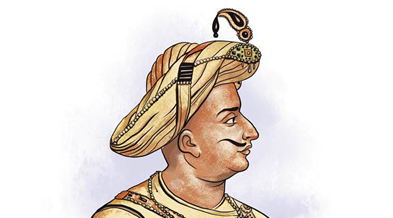 Economic Reforms:
Economic Reforms:
- He established banking networks and cooperatives along with trading houses for Mysore products worldwide.
- He introduced new coins, started a new land revenue system in Mysore and eliminated middlemen in the collection of land revenue.
- He also introduced sericulture, which continues to employ many Kannadigas to date.
- He modernized agriculture, gave tax breaks for developing wasteland, built irrigation infrastructure and repaired old dams
Art and Culture:
- He encouraged the Persians to come down to India to teach the artisans the art of making wooden toys , now famous as Channapatna toys.
- Tipu patronized various temples and Hindu shrines, including Sri Ranganatha temple at Srirangapatna and Math in Sringeri.
Military and Technological Reforms:
- He introduced iron-cased rockets in warfare.
- He set up four innovation hubs in Bengaluru, Chitradurga, Srirangapatna & Bidanur and called them
- He laid the foundations for the construction of the Krishnaraja Sagar dam in Mandya.
Source:
- https://indianexpress.com/article/explained/tipu-sultan-how-history-remembers-him-why-controversy-doesnt-forget-him-8283738/
Click the link below to attempt the daily MCQs and the Mains based questions.
Share the article
Get Latest Updates on Offers, Event dates, and free Mentorship sessions.

Get in touch with our Expert Academic Counsellors 👋
FAQs
UPSC Daily Current Affairs focuses on learning current events on a daily basis. An aspirant needs to study regular and updated information about current events, news, and relevant topics that are important for UPSC aspirants. It covers national and international affairs, government policies, socio-economic issues, science and technology advancements, and more.
UPSC Daily Current Affairs provides aspirants with a concise and comprehensive overview of the latest happenings and developments across various fields. It helps aspirants stay updated with current affairs and provides them with valuable insights and analysis, which are essential for answering questions in the UPSC examinations. It enhances their knowledge, analytical skills, and ability to connect current affairs with the UPSC syllabus.
UPSC Daily Current Affairs covers a wide range of topics, including politics, economics, science and technology, environment, social issues, governance, international relations, and more. It offers news summaries, in-depth analyses, editorials, opinion pieces, and relevant study materials. It also provides practice questions and quizzes to help aspirants test their understanding of current affairs.
Edukemy's UPSC Daily Current Affairs can be accessed through:
- UPSC Daily Current Affairs can be accessed through Current Affairs tab at the top of the Main Page of Edukemy.
- Edukemy Mobile app: The Daily Current Affairs can also be access through Edukemy Mobile App.
- Social media: Follow Edukemy’s official social media accounts or pages that provide UPSC Daily Current Affairs updates, including Facebook, Twitter, or Telegram channels.


